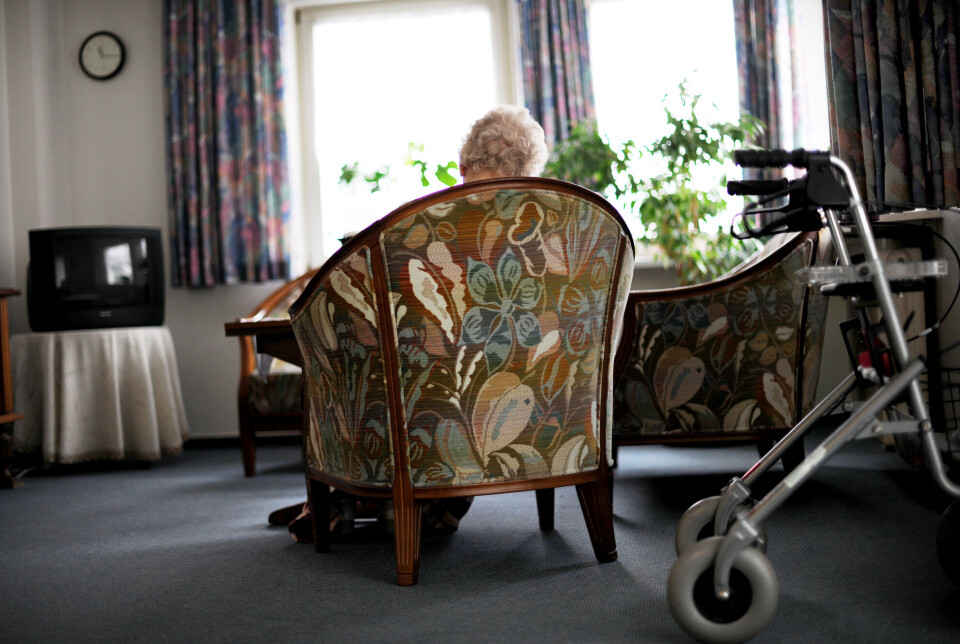
Study: Every sixth person over 70 had dementia — low educational levels gave a 3- to 6-times greater risk
Women and the elderly with only a primary education are much more at risk than the highly educated. “Fortunately, there’s a great deal people can do preventatively,” a researcher at the Norwegian University of Science and Technology (NTNU) says.
More and more people are developing dementia. But study results vary when it comes to estimating exactly what our risk of developing dementia is as we age.
Many studies have shown that women are more vulnerable. And that people who have attended the ‘school of life’ are worse off than people with more education.
Where you live may also be a factor. Living in cities seems to result in a higher risk than living in towns or rural areas.
Now, Norwegian researchers have examined a number of people from the greater Trondheim area to see if these findings hold true. The study has been published in the Journal of the Norwegian Medical Association.
More than 11,400 people from Trøndelag Country under the microscope
One of the largest health studies in Norway, the Trøndelag Health Study (HUNT), generally includes participants from the northern part of Trøndelag County.
But now residents over 70 from the city of Trondheim have also been allowed to join.
Using a series of tests, a team of nine doctors diagnosed dementia and mild cognitive impairment in participants. The researchers also collected information on participants' educational levels.
The researchers then compared the incidence of dementia in participants from HUNT4 70 + with city residents in HUNT4 Trondheim 70+.
One in six had dementia
Fully 21 per cent of individuals in the sample from Trondheim aged 70 and over had dementia. To put this in context, the incidence in the northern parts of Trøndelag was ‘only’ 15.7 per cent.
But there were differences in the composition of participants in these two geographical areas. The researchers consequently adjusted for age, gender, education and the proportion of nursing home residents.
The incidence of dementia was then calculated to be 16.2 per cent in Trondheim and 16.4 per cent in Nord-Trøndelag, or approximately the same in the city and the outlying towns and countryside.
Part of the explanation for the change was that there were more than twice as many nursing home residents in the Trondheim group as in the Nord-Trøndelag group.
This difference shows how important it is to adjust for these kinds of factors, the researchers point out.
Women more vulnerable
Women were more prone to develop dementia than men. As many as 18.6 per cent of women in Trondheim and 17.8 per cent of women in Nord-Trøndelag had dementia.
Among men, the proportion was ‘only’ 13.1 and 14.8 per cent.
Women consequently had an increased risk of between 3 and 5 percentage points, which is consistent with previous studies.
Low education linked to a three- to six-times greater risk
The more education a person had, the better protected they seemed to be against dementia.
Only 6 to 8 per cent of those with a university or college education had dementia. Trondheim had the highest incidence.
Around 13 per cent of study participants with an upper secondary education were affected.
And between one-third and one-quarter of participants with only a primary education had dementia. This translates to an incidence that is three to six times as high as the incidence in academics.
More Trondheim residents with low educational levels had dementia
There was also a difference between the city and outlying areas when the researchers looked at the participants' level of education.
Far more city residents with low educational levels had dementia than in the countryside or cities north in Trøndelag.
In Trondheim, fully 35.5 per cent of those with only a primary school education had dementia.
In Nord-Trøndelag, the equivalent number was 26.1 per cent. These proportions were after the researchers adjusted their data to reflect differences in the two areas.
One in three had mild cognitive impairment
The differences were less pronounced between the city and countryside when it came to mild cognitive impairment. In both places, just over 35 per cent of the participants had mild cognitive impairment.
In a recently published meta-study, 19 per cent of people in the 70-79 year-old age group had mild cognitive impairment. The HUNT study from Nord-Trøndelag was included in this study.
But there were differences among the highly educated.
In Trondheim, 35.2 per cent of the elderly with a high level of education had mild cognitive impairment.
In Nord-Trøndelag, far fewer were affected. Here, "only" 28.4 percent suffered from mild cognitive impairment.
Strength in the numbers
“The study has been very solidly conducted by a research group with great deal of expertise both in epidemiological research and with clinical knowledge of dementia,” said NTNU Professor Ingvild Saltvedt, who was not involved in the study.
Saltvedt works at the university’s Department of Neuromedicine and Movement Science.

“It would have been optimal for every single patient to be examined individually, but that’s not feasible when you are working with such a large amount of material. The strength of the study is precisely that there are so many participants from both Nord-Trøndelag and Trondheim, and that the results agree so well,” she wrote in an email to sciencenorway.no.
Can be prevented
Saltvedt said she finds it thought-provoking to see that roughly half of the elderly in the study showed cognitive impairment, especially considering that the percentage of elderly in the population will continue to grow in the future.
“One positive thing is that the development of dementia can be prevented to a certain extent through a healthy, active lifestyle. In other words, engaging in physical, mental and social activity,” she said.
This is in addition to optimal treatment for risk factors such as high blood pressure, obesity, diabetes, impaired hearing, she added.
Higher figures than in other studies
The incidence of dementia in both geographical areas is higher than in several other recent studies.
This may be due to the medical criteria that researchers used.
It may also be due to the fact that the number of frail elderly people included in different studies varies, as can the specifics of the different age groups included in the studies.
Nevertheless, the prevalence of dementia in Trondheim and Nord-Trøndelag is quite similar to what has been found in two studies from Sweden and Finland.
This study offered study participants the opportunity to be involved via home visits and nursing home surveys. That might mean that more people with dementia took part in this study than in other studies.
Weakness that just one Trondheim district included
The researchers themselves pointed out two factors that may have led to the selection being skewed.
In Trondheim, the researchers only included people from the city’s Østbyen district. This may have influenced the representativeness of the sample for the whole of Trondheim. The city has four districts.
Another issue was that fewer people took part in Trondheim – 33.8 per cent – compared to Nord-Trøndelag, where fully 51 per cent took part.
The HUNT study is well known in Nord-Trøndelag and has been ongoing since the 1980s.
The study is a collaboration between researchers at the National Centre for Ageing and Health, the Norwegian Institute of Public Health, NTNU and the HUNT research centre.
Translated by Nancy Bazilchuk
Reference:
L. Gjøra et al.: Demens og mild kognitiv svikt hos eldre personer i Trøndelag (Dementia and mild cognitive impairment in elderly people in Trøndelag). Tidsskriftet Den Norske Legeforening (Journal of the Norwegian Medical Association), 2023.
———
Read the Norwegian version of this article at forskning.no
































